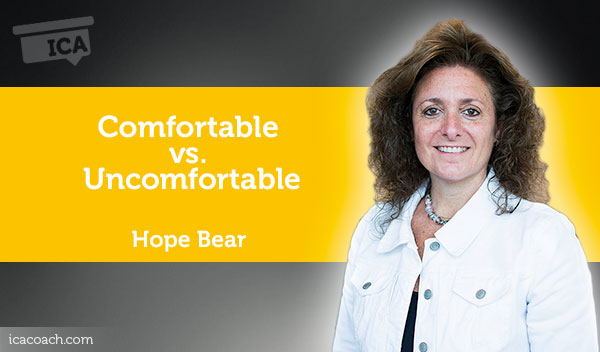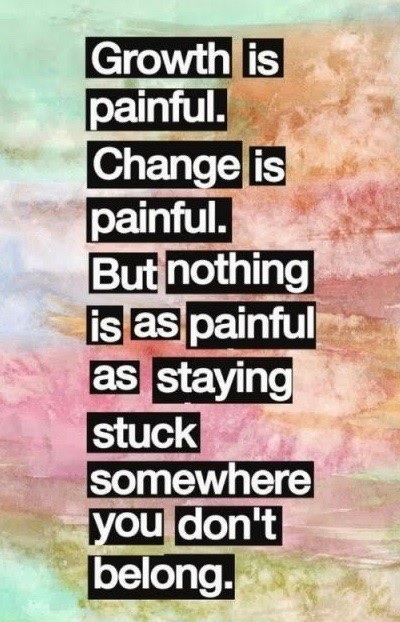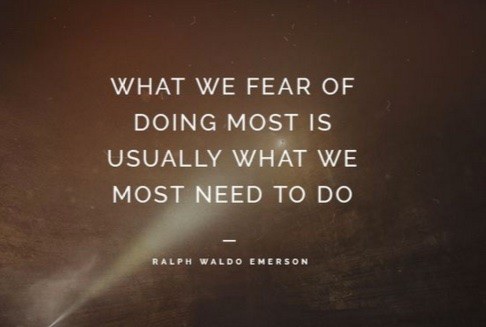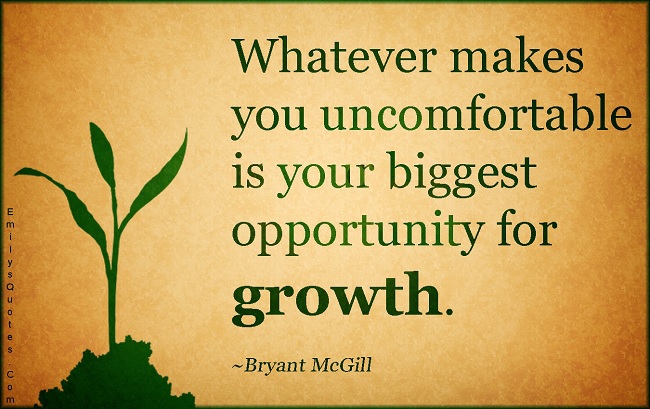
A Coaching Power Tool Created by Hope Bear
(Coach, UNITED STATES)
We know that people grow and develop the most when they are placed in uncomfortable situations. If this is the case, why is it human nature to want to stay in comfortable situations?
The definition of comfortable is:
As human beings we long to feel comfortable and feel free from doubt, stress and tension. The challenge with staying comfortable is that growth cannot be achieved and you risk being stagnant and bored. Often times when an individual is placed in a new environment or situation, they begin to feel uncomfortable since there is an element of “the unknown”. Usually, accompanying the “unknown” are feelings of fear, doubt, and insecurity. These emotions are powerful and instinctively, human beings will do whatever it takes to find comfort. There are two paths to finding comfort; however, only one of leads to growth. One path, to finding comfort, is usually found by going back or returning to what one knew or experienced. The result, of traveling down this past, is “living in a gap” where no forward movement exists. It might feel comfortable and safe in the short term; however, this path does afford you the opportunity to learn, grow, and improve.

The other path is much harder; however the results are much greater. This path is achieved when an individual exerts a great deal of courage to confront their fears, exerts energy to keep moving forward, is determined to work through the “uncomfortable” and shows commitment to endure the journey which will ultimately lead to growth.
The definition of uncomfortable is:

Feeling uneasy can be scary, stressful and exhausting; however once those feelings are addressed, acknowledged and resolved; the “unknown” becomes familiar, and uncomfortable feelings are replaced with a sense of accomplishment, signifying that growth has occurred. Once an individual has successfully forged a new path, they are better equipped to travel new roads in the future and continuously grow and develop.
Self Application
After four years of marriage, I realized that my marriage was no longer working. At the time, I had a daughter who was 1 ½ years old and I knew that I had to leave. For one year, I lived “in the gap”, fearful of what lied ahead and miserable living my everyday life. At the time, I thought that I found comfort, knowing what each day would bring. However, as time went on I felt more and more trapped, frustrated, isolated and sick. I found myself asking, “Why do I feel so awful and comfortable at the same time?”
It finally dawned on me that I was afraid of making a change, fearful of what people would say, anxious about how my daughter would react and scared that I would not be able to support myself. I was plagued with headaches, insomnia, and began to view life as a chore rather than an experience. At that moment, I knew that I had to make a change because prioritizing “comfort” was slowly eroding me, as a person.
I surrounded myself with friends who I completely trusted and family. I began to focus my energy on achieving my goal; creating a life for my daughter and I, as a single mom. As ideas came, I discussed them with support network and before long, my ideas became actions which helped me to attain my goals. Within 11 months, I saved enough money to rent an apartment, obtained a higher paying job, enrolled my daughter in a new pre-school and moved to a new area. That time in my life was scary; however, I learned a valuable lesson. If I trust and value my abilities, knowledge and capabilities, change can be an empowering experience that shapes who I am as a person. Moreover, all of the hard work and lessons learned proved to be invaluable. I discovered that finding comfort with the “uncomfortable” opened up a whole new world for myself and my daughter. Today, my world is filled with feelings of empowerment, freedom, strength and openness…for the first time in my life, I am not scared of growing and living.
Coaching Application
More often than not, clients are stuck in their “comfort zone” and fearful of feeling “uncomfortable”. It is the coach’s job to support them in their journey, moving from “comfortable” to being “uncomfortable”. The important thing to remember is that each client will have their own unique journey which can be supported with different tools and questions to continuously grow.
Before any movement can happen trust needs to be established to support a deeper awareness and understanding of the obstacles and support/structures which are required to develop the actions. Remember, our client has the answer, and as their coach we need to help them find the answer.
Create a trusting space:
Actively listen to clarify the goal:
Ask powerful questions to better understand what is “comfortable and uncomfortable” so that you are able to create a shift in perspective.
Visualization: What does it look like?
Ensure that the client is relaxed by having them close their eyes. Ask them to focus on each part of their body, (starting with their head, arms, chest, legs, and finally their feet) and take deep breaths. When they exhale, have them release all tension in that specific body part. Once relaxed ask them the following questions:
Use acknowledgement to build trust, strengthen courage, express one’s will and support forward movement to move from a place of comfort to where there is a feeling of discomfort:
Practice Gratitude to support forward movement into areas that might be uncomfortable.
Once your client has moved through the “uncomfortable” feelings and experienced growth, their new perspective will be one of gratitude and acknowledgment for taking the necessary actions. From this moment forward, “comfort” is no longer a gratifying feeling and your client is better prepared and able to continually grow and develop.
